Guide to riding
on roads
Getting around Bendigo by bike is quick and easy if you know how. A 3km trip can take less than 15 minutes by bike.
You don’t have to wear Lycra; you don’t have to go fast – but going by bike for some short trips is an easy way to fit regular exercise into your week.
You’d be surprised at the difference to your health and wellbeing.
Subscribe to stay up to date with our upcoming rides and events, riding tips and advocacy for safer bike routes.
Riding on roads
While there’s plenty of good off-road bike paths around Bendigo, chances are you’ll need to ride on roads at some point to get where you want to go.
Not comfortable riding with traffic? This guide is here to help.
 We recommend also watching our videos: How to feel safer on the roads and Where to ride.
We recommend also watching our videos: How to feel safer on the roads and Where to ride.
Starting out
Follow these five principles to ride safely on roads
Be Visible |
- Ride a metre out from the kerb or from parked cars where you’re more visible to other road users.
- Wearing light or bright colours and using lights (even during the day) will help people spot you early.
Be Alert |
- Know what’s going on around you by regularly scanning ahead and behind.
- ‘Read’ the traffic: anticipate what’s coming up and how you might need to react.
– Watch out for cars parking or pulling out.
– Anticipate pedestrians and cars.
Be Predictable |
- Ride in straight lines.
- Avoid sudden changes in direction.
- Think about what other road users are expecting you to do.
Be Clear – commmunicate your intentions |
- Let others know what you are planning to do (in plenty of time).
- Signal before you turn by extending your arm to the right or left.
- Make eye contact with other road users – to make sure they’ve seen you and communicate your intentions. Especially:
– drivers around you at intersections
– drivers entering from side streets
– pedestrians. - Practice courtesy: a smile and a wave helps keep things harmonious.
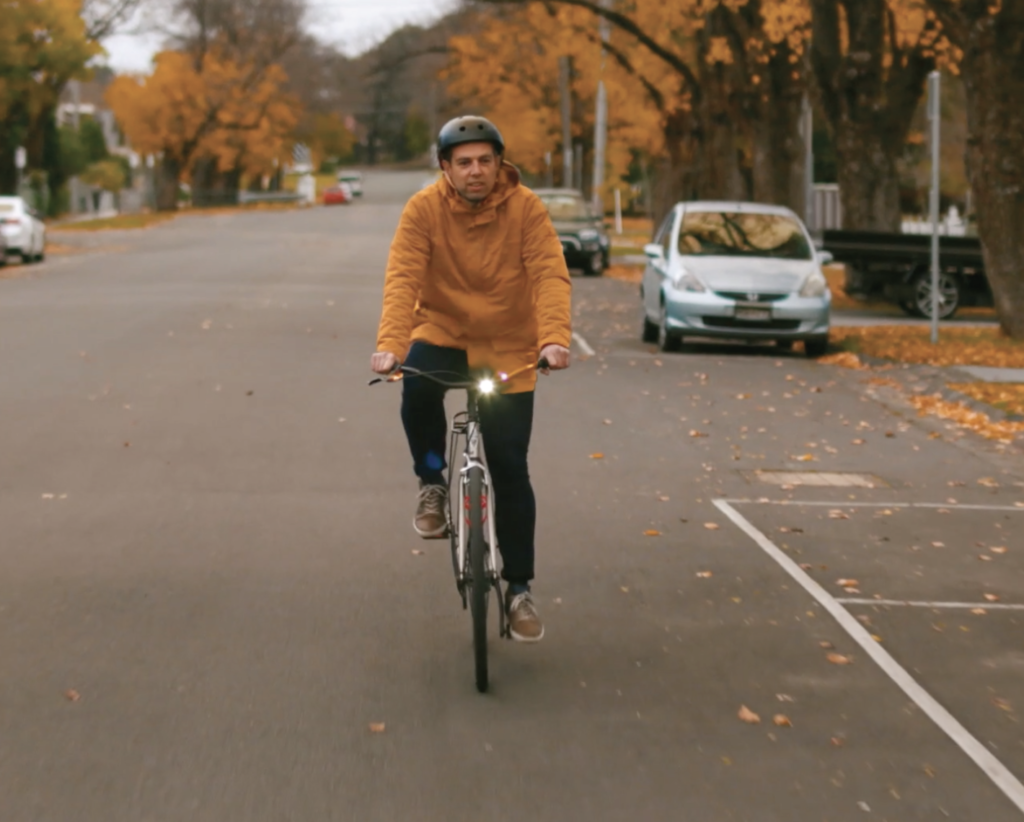
Be In Control |
Be more stable and predictable by:
- starting with your pedal in ‘power position’ to give you momentum as you push off
- being in an easy gear when you start off so you can accelerate easily
- changing gears so you can maintain a constant pedalling speed (ideally turn both pedals at least once a second or 60–80 times/minute)
- changing down to an easy gear as you prepare to stop so it’s easy to start off again
- using the rear brakes to control speed, and both brakes to stop.
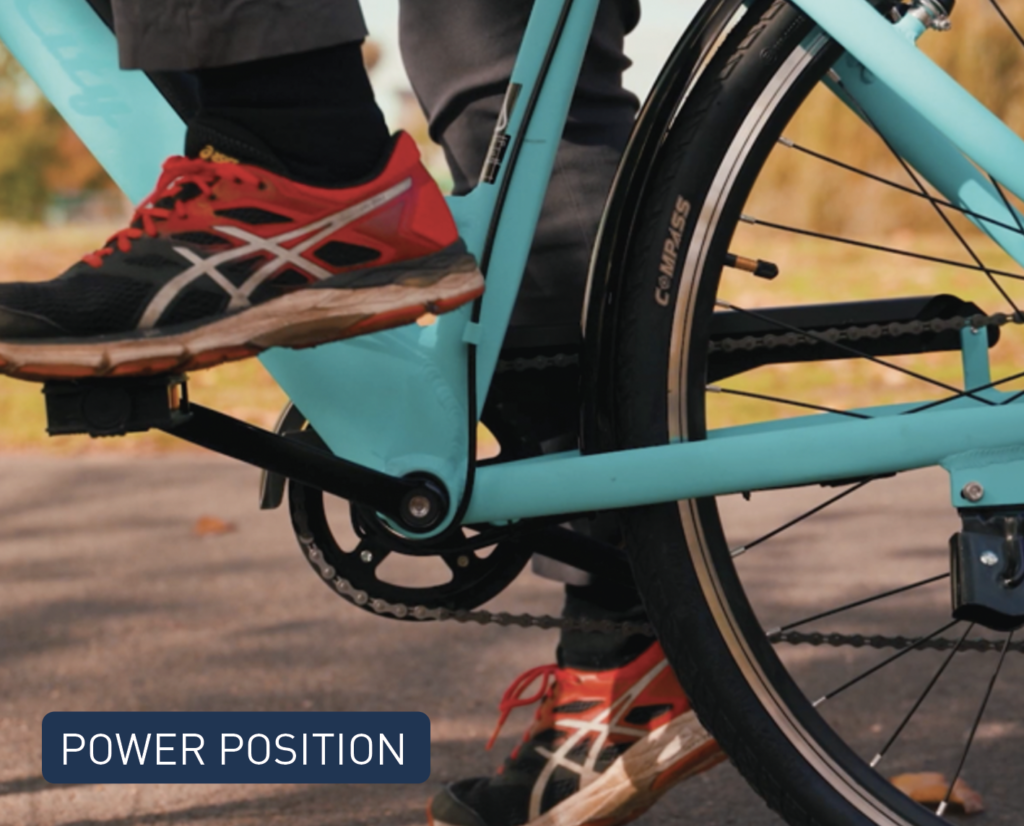
Intersections & roundabouts
Knowing a few strategies to help you negotiate intersections safely on a bike can really take the stress out of riding on roads.
The good news is that there’s often more than one option – so you can do what’s most comfortable for you.
Even walking through an intersection that you don’t feel safe riding through is totally valid.
Follow our step-by-step strategies to help you ride safely and confidently around town:
Changing direction
Any time you need to change direction (including changing lanes), make sure you know what’s going on around you and let others know what you’re intending – just like you’d use your mirrors and indicators in the car.
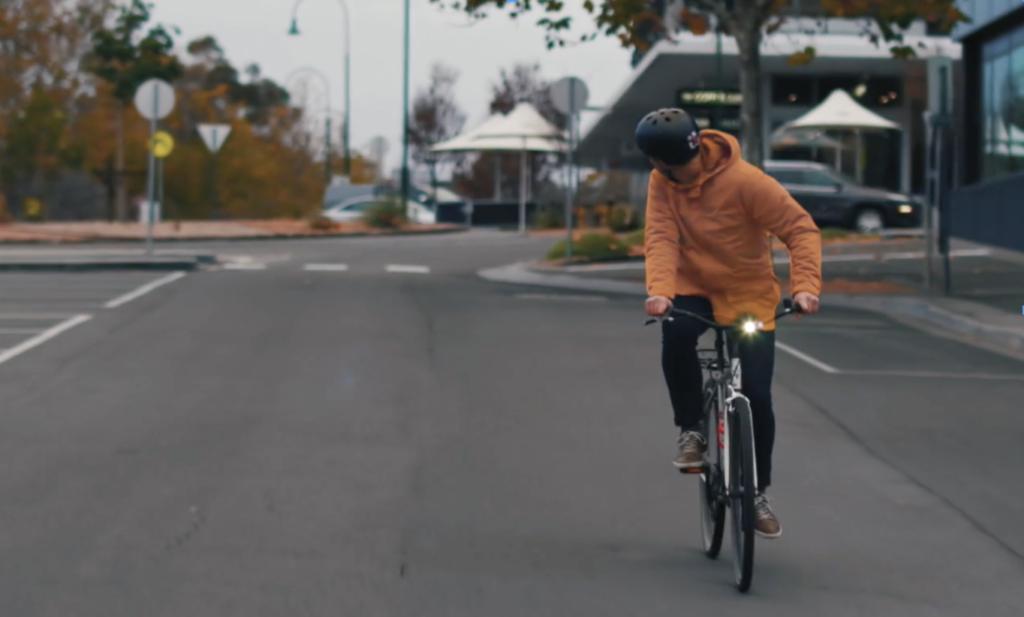
It’s courteous to signal before turning left if you can do so safely but is not a legal requirement.

Turning right
From a side street |
Turning right from a side street – at a give-way or stop sign, for example – is similar to how you’d turn right in a car.
- Scan behind, signal, then move into centre of lane (take the lane) if it’s safe.
- Signal again, give way to oncoming traffic and pedestrians crossing the road you are about to enter, then turn if it’s safe. Or stop and wait until clear.
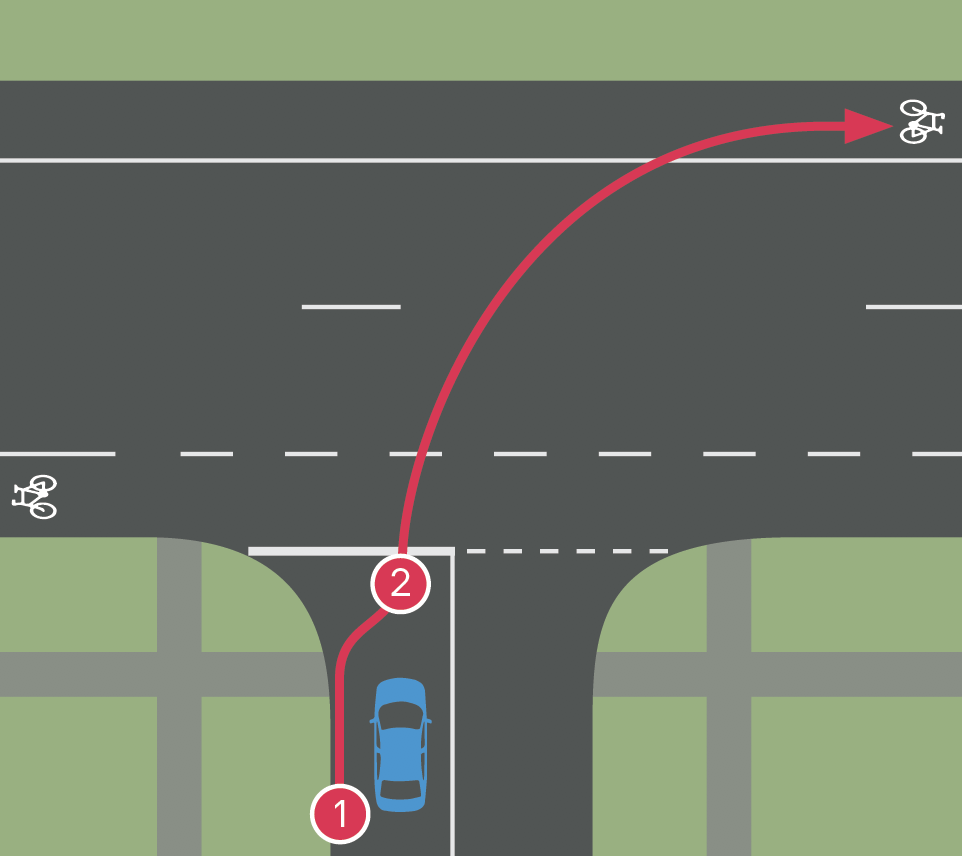
Into a side street |
You have some options here. If the road you are turning from is quiet enough and you feel confident moving into the centre of the road:
- Scan behind, signal and move across when safe.
- When you are opposite the lane you are turning into, wait just left of the centre line, signal again and turn right, giving way to oncoming traffic and pedestrians crossing the road you are about to enter.
If the road you are turning from is busy, or you are not comfortable turning from the centre of the road, a hook turn may be your best option.
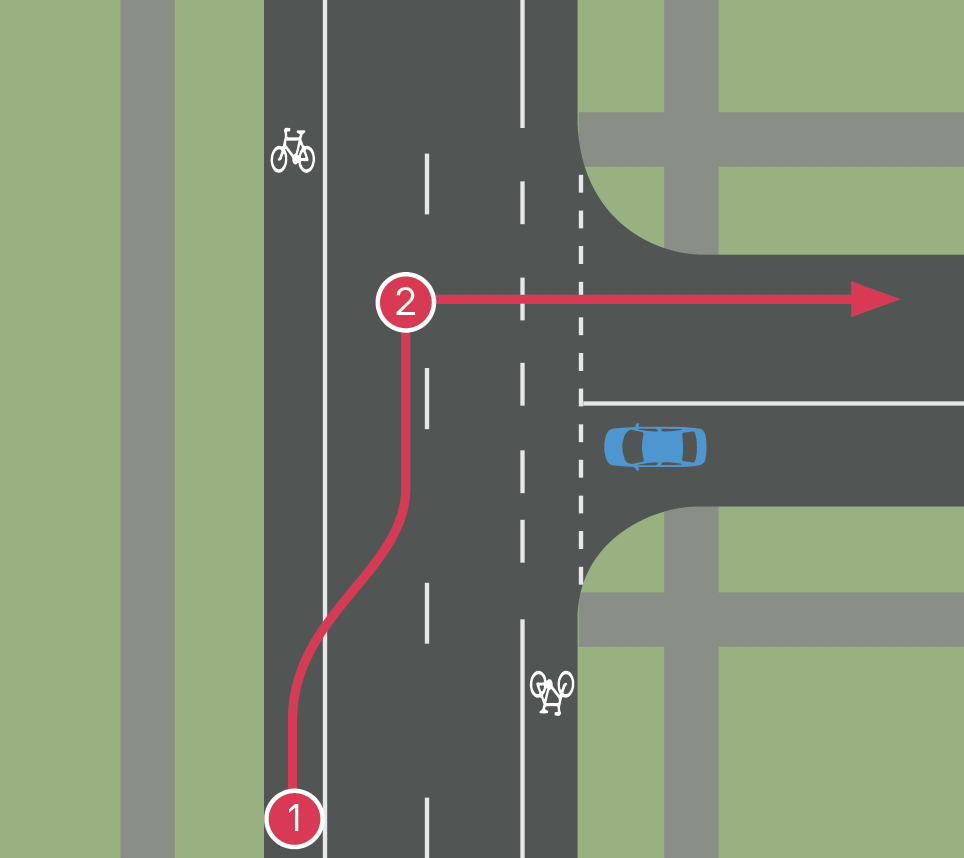
Hook turns |
A hook turn means turning right from the left side of the road.
For motor vehicles, this is only permitted at certain intersections where it is clearly signed, such as on tram routes in Melbourne’s CBD.
Bikes can legally make a hook turn at any intersection unless a sign forbids it – and it’s often the safest way to turn right.
How to make a hook turn when turning from a busy road into a side street
- Pull over to the far left of the roadway
- Turn your bike (or front wheel) to face the side street so you can clearly see traffic coming from both directions
- Give way to traffic in both lanes and vehicles turning right out of the side street
- When safe, ride (or walk) across the road into side street.
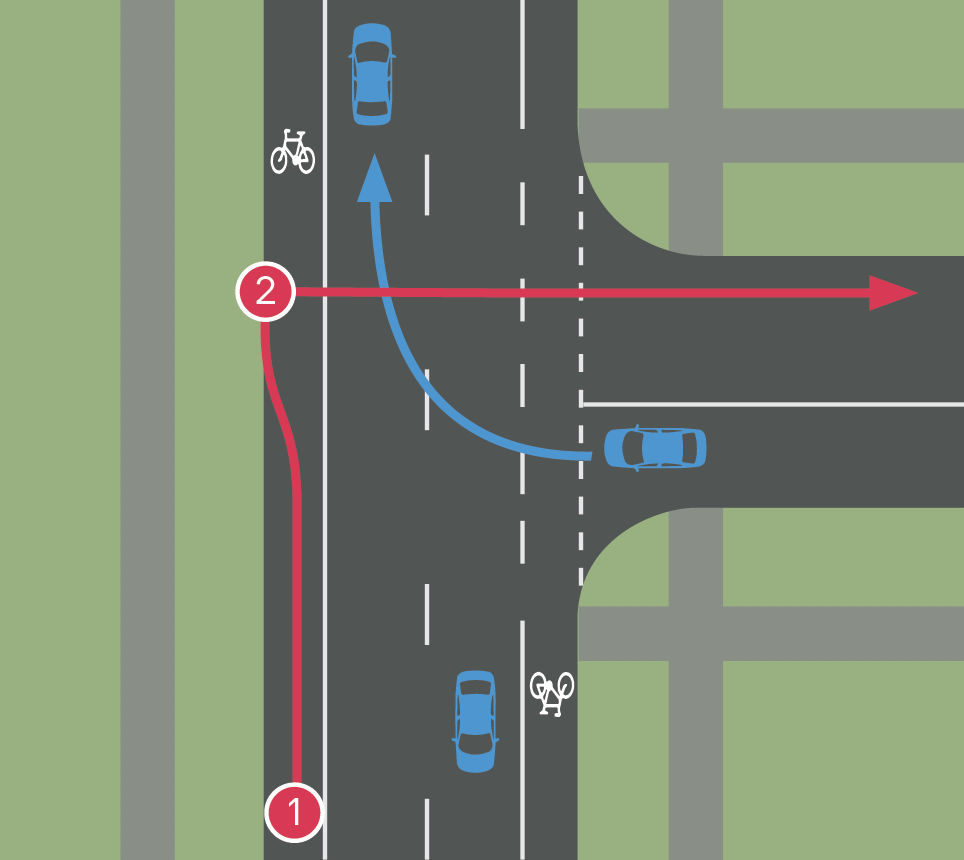
Signalised intersections
Chances are there will be other vehicles around you at traffic lights. Stay safe by being as visible as possible (including waiting where you can be seen) and moving through predictably and without delay.
Where to stand at the lights |
Wait at the front of the traffic if you can get there safely: you are more visible here.
(The exception is around large trucks, which have a large blind spot in front and along each side. Always stand behind trucks at intersections.)
A bike box gives you a dedicated space to wait.

If there’s no bike box, stand where cars see you clearly and give you space – e.g.:
- in front of the waiting cars, or
- beside the front car.
If it’s not safe to move to the front, wait behind cars in the centre of the lane so you are more visible and keep space around you.
Acknowledge drivers near you, making eye contact to ensure they’ve seen you.
If you don’t feel safe, pull over and walk your bike on the footpath.


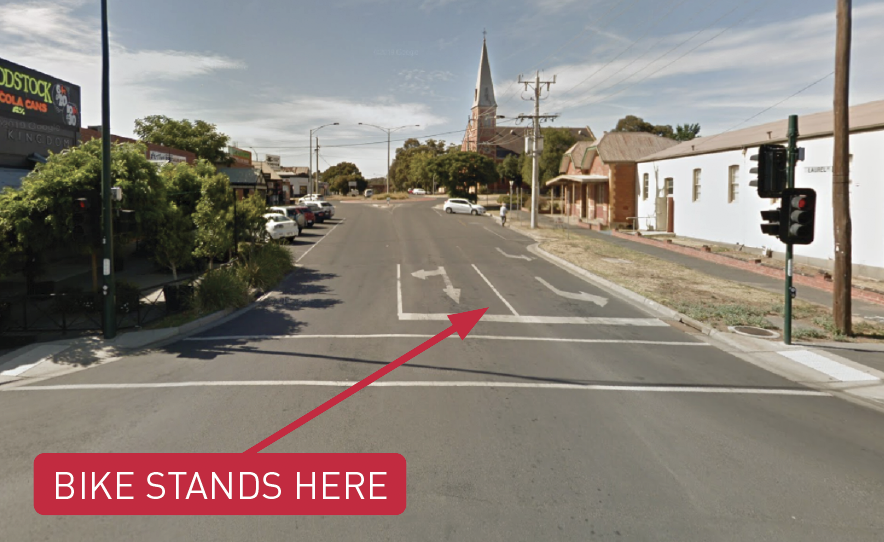

Going straight at the lights |
In general, you’d ride in the left-most lane through an intersection.
But be aware of vehicles turning left across your path as you enter the intersection. Watch what they’re doing – and give way to anyone already turning when you reach the corner.
Stay visible: take the lane through the intersection. Move to the left once you’re clear of left-turning cars.

Dedicated left-turn lanes
To avoid left-turning traffic, move into the straight-ahead lane as you approach an intersection with a dedicated left-turn lane or green arrow. If the lights are red, wait to the right of the left-turn lane.

Take the lane through the intersection, moving to the left once you’re clear of left-turning cars.

Turning right at traffic signals |
A hook turn is generally the safest way to turn right at traffic lights. Another option is to make a reverse hook turn, walking your bike across the pedestrian crossings when the pedestrian light is green.
To make a hook turn at lights:
- Ride straight to the far left of the intersection.
- When you reach the far side, wait in front of the pedestrian crossing. Turn your body and front wheel to face the direction you want to travel. (Be sure to wait ahead of the straight-ahead traffic queue: don’t wait in front of a dedicated left-turn lane. Never wait in front of large trucks.)
- On the green light, ride through the intersection, merging into the bike lane (if there is one).
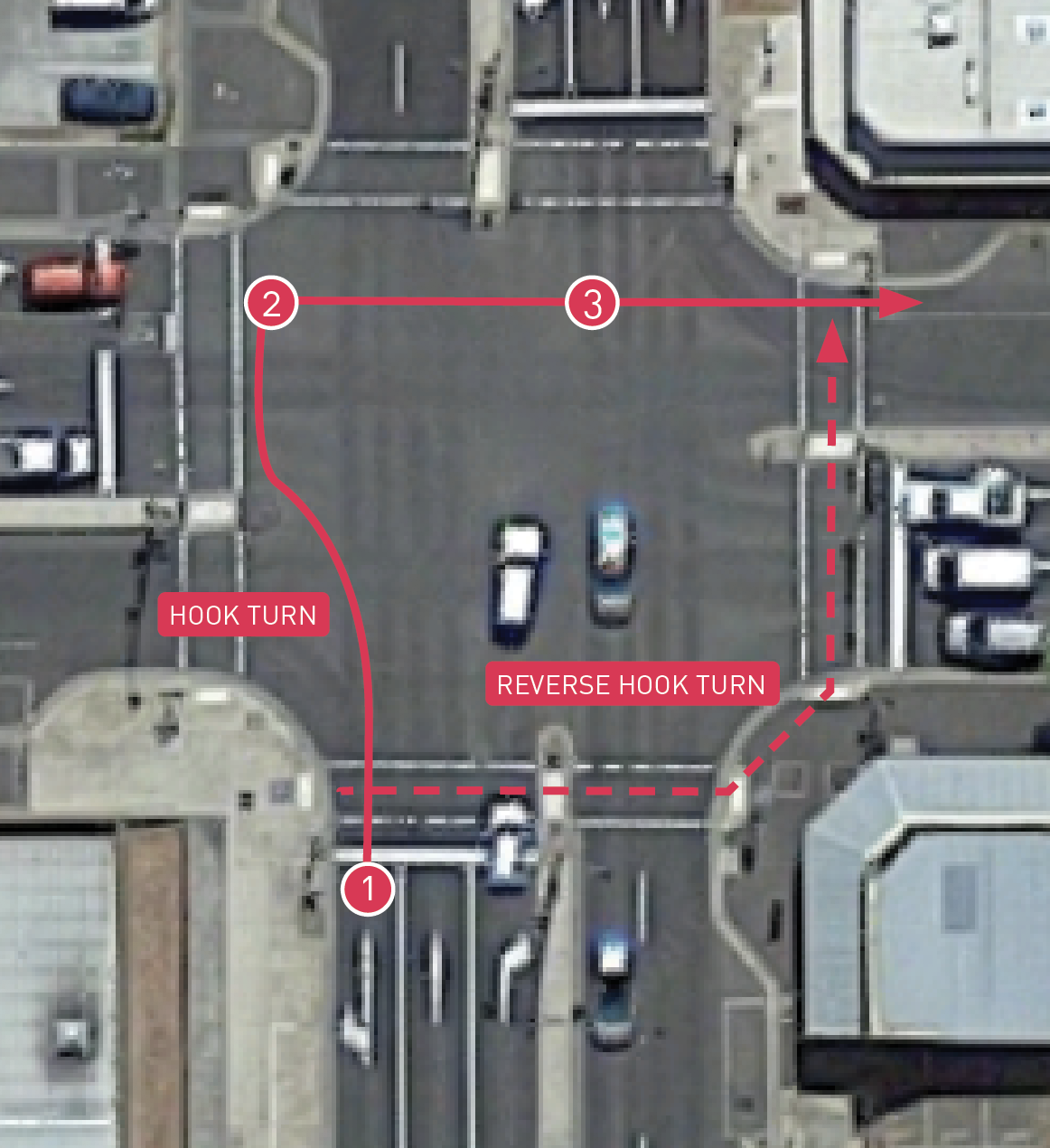
Turning right using the right turn lane
Bikes can also turn right from the right-turn lane (as a motorised vehicle would). Just like in a car, check and signal then move into the right lane. Claim each lane as you merge across, then hold the middle of the right turn lane before the turn.
As you turn, you want to end up in the left lane, rather than the right (as cars would). Make a wider turn through the intersection so that you enter the left lane. Once through the intersection, merge left into the bike lane (if there is one) or continue in the left traffic lane.

Roundabouts
In low-speed environments, bikes can travel through roundabouts as quickly as cars.
Roundabouts usually don’t have bike lanes: the idea is that bikes ‘take the lane’. Riding in the middle of the lane keeps you visible and prevents cars squeezing past.
Some roundabouts have painted ‘sharrows’ (shared lane arrows) indicating that bikes should merge into the traffic lane as they approach a roundabout. This works okay at slow traffic speeds but in higher speed environments (60km zones) can be daunting unless you are confident and able to maintain a good speed on the bike.

Single-lane roundabouts |
How to ride straight through
- As you approach the roundabout, check for traffic, then signal and move into the middle of the traffic lane when safe.
- Give way to traffic in the roundabout.
- Continue to hold the traffic lane as you ride through the roundabout so cars don’t try to squeeze past.
- Merge left into the bike lane (if there is one) after you exit the roundabout.

How to turn right
To turn right, follow the same procedure.
- Signal your intention to turn right as you approach the roundabout.
- Give way to traffic in the roundabout before entering.
- Hold the traffic lane, briefly signaling right as you ride through the roundabout.
- Merge into the bike lane (if there is one) after you exit the roundabout.
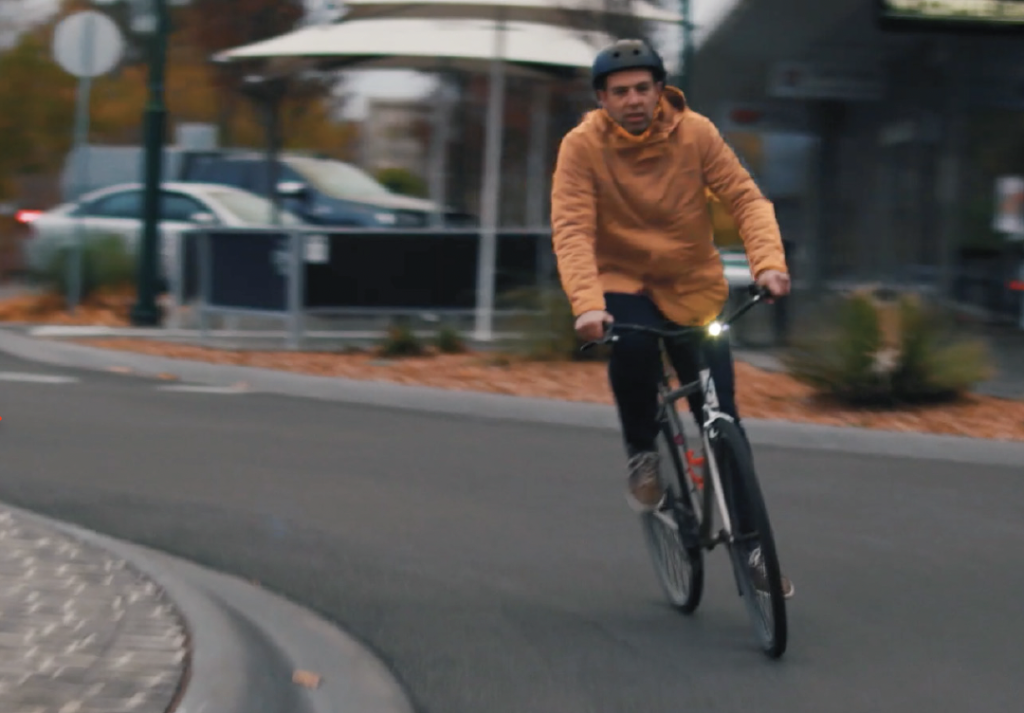
Roundabouts with bike lanes
When turning right at a roundabout with a bike lane around the outside, it is safer to take the traffic lane and signal clearly.

Multi-lane roundabouts – low speed |
In a low-speed zones (e.g. 40kph), riding through a multi-lane roundabout is straightforward when you follow these strategies:
How to ride straight through
- As you approach the roundabout check for traffic, then signal and move into the middle of the left traffic lane when safe.
- Give way to traffic in the roundabout.
- Continue to hold the left lane as you ride through the roundabout so cars don’t try to squeeze past.
- Merge left into the bike lane (if there is one) after you exit the roundabout.
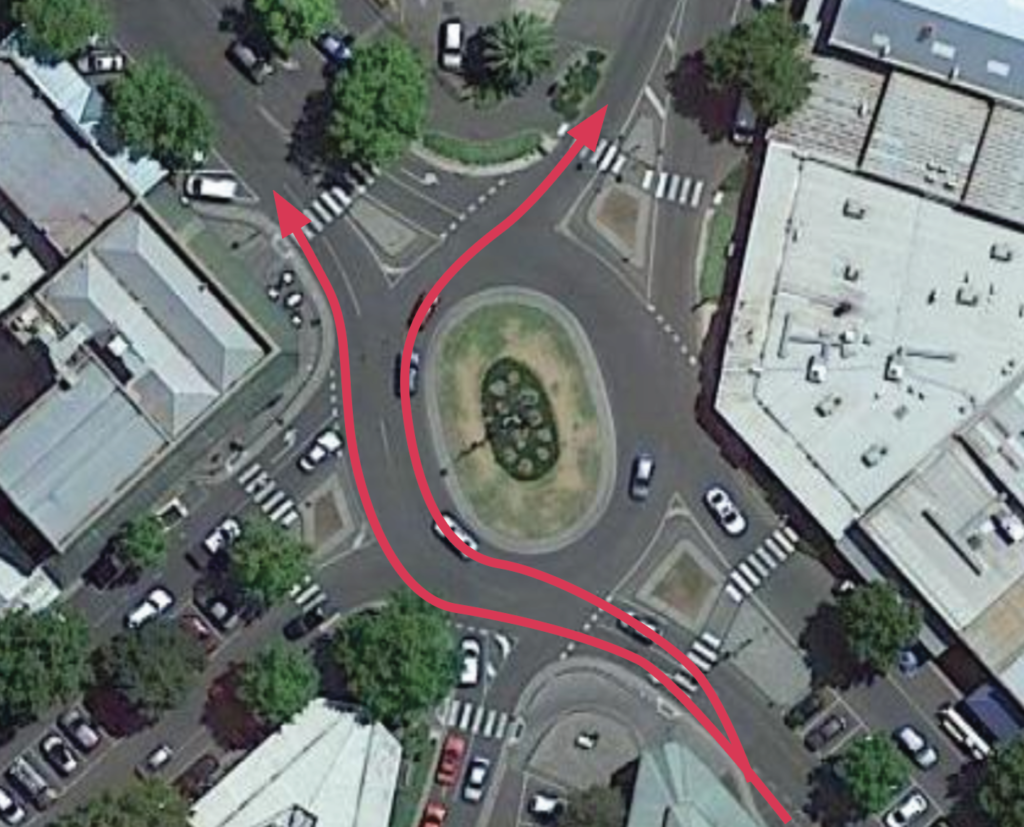
How to turn left
Use the same approach for riding straight through. Signal your left turn if you can.
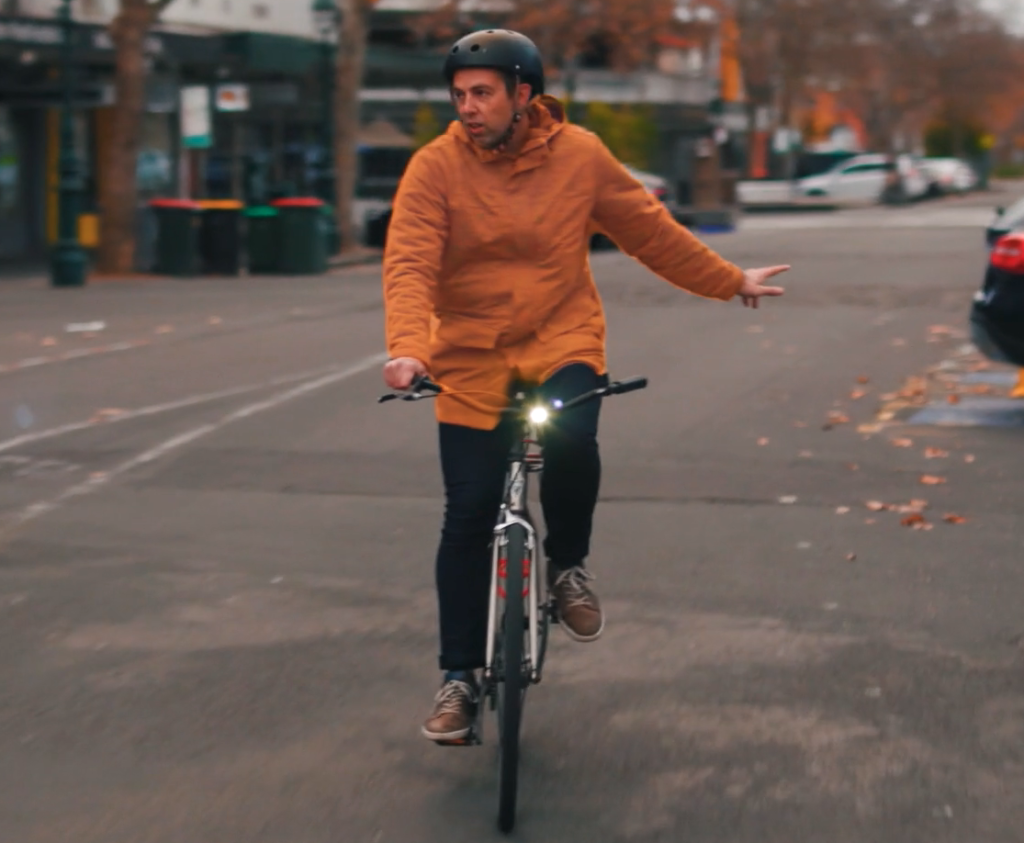
How to turn right
- As you approach the roundabout check for traffic, then signal and move into the right traffic lane when safe.
- Claim the right lane and signal your right turn.
- Give way to traffic in the roundabout before entering.
- Remain in the right lane as you ride through the roundabout. Signal as you begin to turn.
- As you approach the roundabout exit, merge to the left side of the right lane.
- Check behind you for traffic and, if safe, merge into the left (outside) lane. Communicate your movements to other road users as much as possible using hand signals and/or eye contact.
- Merge left into the bike lane (if there is one) after exiting the roundabout.

Multi-lane roundabouts – higher speed |
Unless you’re confident riding among fast-moving traffic, including changing and holding lanes, avoid multi-lane roundabouts in higher speed (60kph+) environments.
What are the alternatives?
- Find a different route – quieter parallel roads are safer and more pleasant – and you may not have to go too much out of your way.
- Use the footpath. If there is no good alternative, skirt around it on the footpath. Sure, this option takes a little longer, but it’s lower-stress.
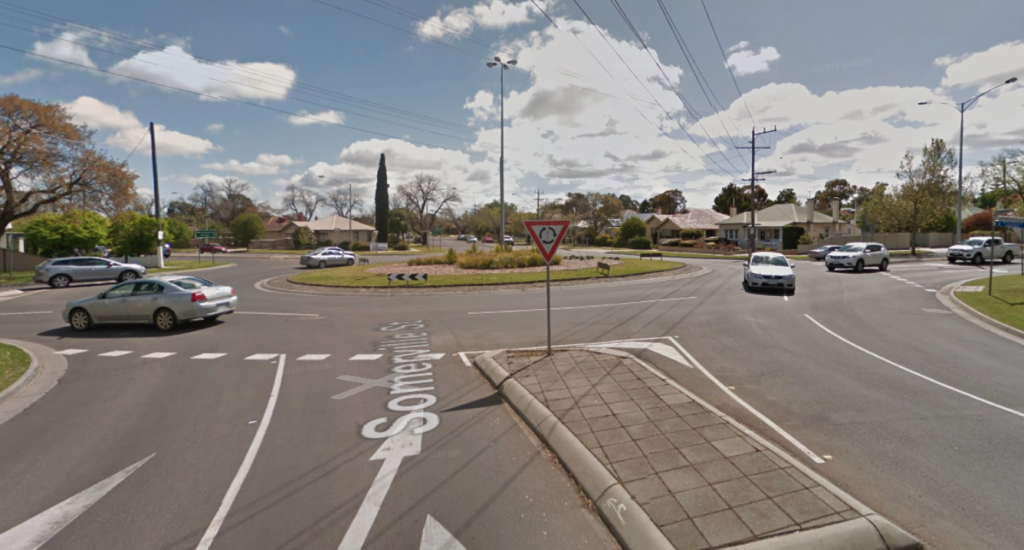
Go by bike!
Going by bike for some of your trips is an easy way to build incidental exercise into every week.
Not only is it fabulous for physical and mental wellbeing, you’ll also find yourself more connected to your local environment.
Once you start, you’ll be surprised how often you can use the bike for a short trip!
![]() Follow us on Facebook and subscribe to hear about Bike Bendigo rides and events.
Follow us on Facebook and subscribe to hear about Bike Bendigo rides and events.
This guide has been produced with support from the VicRoads Community Road Safety Grants Program and the City of Greater Bendigo.

